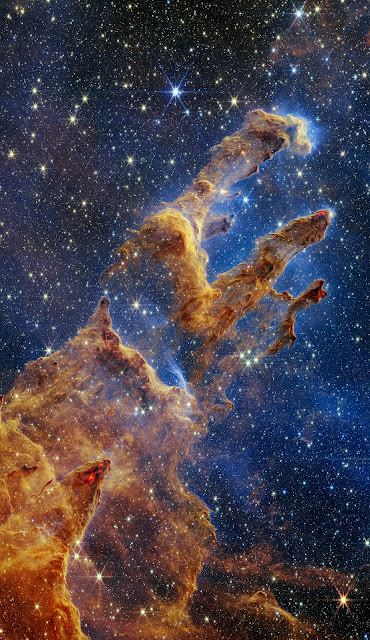I like to end my blogging day by leaving a nice photo at the top of the page. Can't do much better than an updated view of this remarkable formation.
Small red dots on the edges of the pillars are baby stars—only a few hundred thousand years old, according to the Webb team. The red, lava-like streaks in the clouds are ejections from stars being formed. These nascent gas balls send off jets of material that strike the gas in the pillars, causing energetic hydrogen molecules in the system to glow...The pillars—brown and turbid in Hubble’s view—appear luminous and orange to Webb. The backdrop of gas and deep space turns from an opaque turquoise to a bedazzlement of stars, shining through a sea of lapis lazuli gas. That’s because Webb’s image highlights the hydrogen atoms in the gas, which shine in blue light. The Webb telescope’s infrared eye also penetrates through dense clouds of dust and gas, allowing it to see previously unknown regions of star formation.
More at Gizmodo.


Anybody else see a hand here? :-)
ReplyDeleteSandra
Yes. It is a claw. The Claw of Gorgo.
ReplyDeleteJust a quick warning: please realize that the Webb telescope is an infrared telescope: it sees pretty much nothing that has color, some faint red as best.
ReplyDeleteSo, while it's ok to marvel at these images because they're amazing, please realize that the colors are made-up. Infrared is radiation just to the red side of the visible spectrum. Generally, we think of infrared radiation as heat (even though that comes with some asterix as well, but that goes too far).
So, think of these images as colored heat maps. Kinda like the green images you remember from the night vision stuff in the Iraq war, but infinitely more fancy.
More on how exactly they are colored:
ReplyDeletehttps://www.forbes.com/sites/jamiecartereurope/2022/07/18/yes-nasa-did-manipulate-the-webb-telescopes-first-color-images-last-week/?sh=253abab3e41a
Today NASA released images taken in the mid-infrared spectrum via their MIRI instrument. This hides most of the stars, because the energy in that part of the spectrum is absorbed by the dust.
ReplyDeletehttps://www.nasa.gov/feature/goddard/2022/haunting-portrait-nasa-s-webb-reveals-dust-structure-in-pillars-of-creation